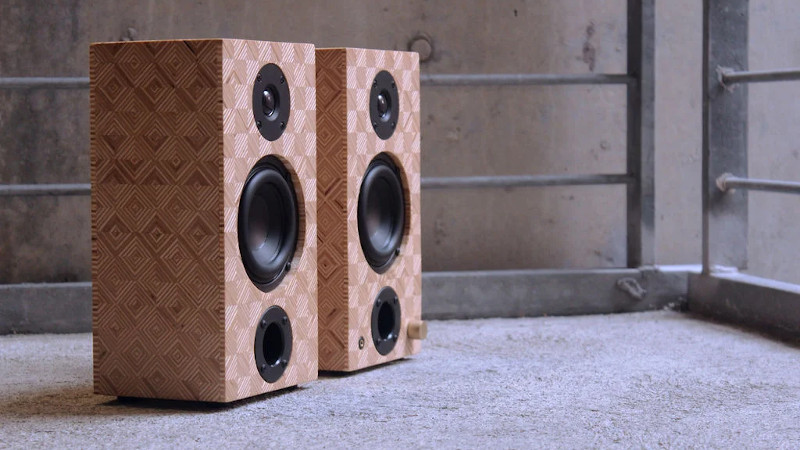In the matter of audio, we’re well past the reign of the home hi-fi and the boombox. If you’re not listening on headphones or directly on your phone, you’ve got a brick-sized Bluetooth speaker pumping out the tunes. Still a fan of the old-school, [Amanda Ghassaei] built some bookshelf speakers with a hip aesthetic.
First, the speaker enclosures were designed in WinISD, a software package specifically made for the task. For given woofers and tweeters, it helps get the enclosure and port sizes in the correct range for good sound. Panels were then fabricated out of plywood to make the enclosures. The plywood was cut and reformed several times to make the panels, using the pattern from the multiple plies to create the zig-zag look. Audio wise, a class D amplifier takes in line-level signals, before pumping them out to a woofer and tweeter through a custom designed crossover network.
It’s a tidy build, and we’d love to experiment ourselves with the fancy patterned plywood technique. Getting your enclosure design right can make a big difference to sound quality, as we’ve seen before. Video after the break.
















Neat!, I have to confess I first thought this is another wood-type 3D print with specialized printing pattern :) (which would have been cool as well)
I guessed laser engraving. This is better, of course!
looks neat, but even with the thinnest sawblade, that’s an enormous amount of wood to waste (or turned into sawdust). but looks really nice.
Not as bad as the efficiency of ACME toothpick factory on cartoon trees.
https://www.youtube.com/watch?v=vh7DQZ4ukxg
Would be an excellent use of cut offs though – CNC/wood shops are always overflowing with plywood scrap and the process seems like it wouldn’t loose too much efficiency or aesthetics if you have to use a bunch of odd size stock pieces.
Just watching all the cutting and gluing and re-cutting and re gluing its really looks like a form of additive manufacturing
I imagined from the title it was a pattern from CNC carving the ply, not using it edge on. But cool.
Here’s my record cabinet with same technique.
“If you’re not listening on headphones or directly on your phone, you’ve got a brick-sized Bluetooth speaker pumping out the tunes.”
To each their own I guess.
For me the sound of someone playing music on some tiny little cellphone speaker is right up there with nails on a chalkboard. There are some nice bluetooth speakers but most I think are just the factory’s way to use up the remaining speakers from the previous generation of cellphones, stuffed in a crappy box that was in no way acoustically engineered. Yuck!
Maybe if one stuck with really old music that was meant to be listened to on an AM transistor radio… that might sound ok on a cellphone speaker.
+1 -I might even prefer nails on chalkboard. Not sure what it is, I just can’t stand music from cell phones or (usual) bluetooth speakers. At least make it sound decent if you’re going to make others listen to it.
Certainly a step up from cell phone speakers or small BT boxes but still no comparison to properly made old fashioned big box speakers connected to a good amp. Lifestyle changes have moved us away from quality sound and most people are content with what they have or an incremental improvement like this project. Unfortunately, audio science exists and can easily demonstrate frequency range, response and room interaction that limit near field boxes, no matter how cleverly made, to mediocre sound.
Very pretty build. Very inefficient and I am not sure it is the best for a speaker cabinet. Generally you want something very dense and stiff. But still very pretty. I doubt I will ever try it though. I get sad enough loosing 3/32 of an inch to the bandsaw blade in my sawmill. The thought of buying plywood and loosing 1/8″ per cut on many many cuts on material I had to pay for would be too hard for me to swallow.